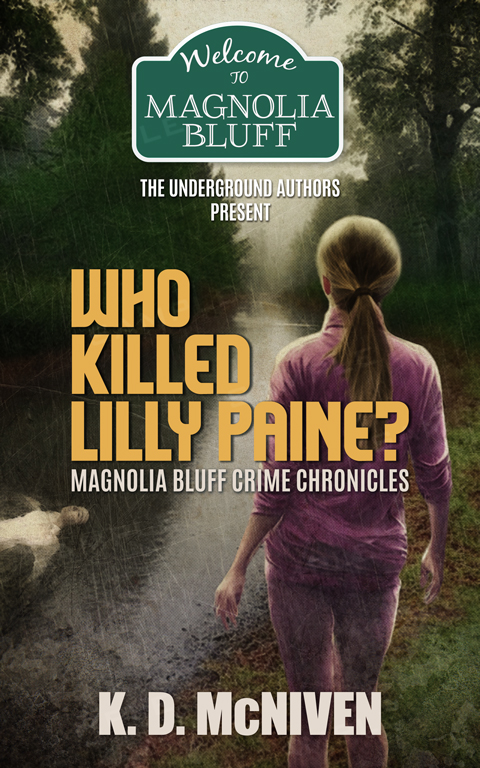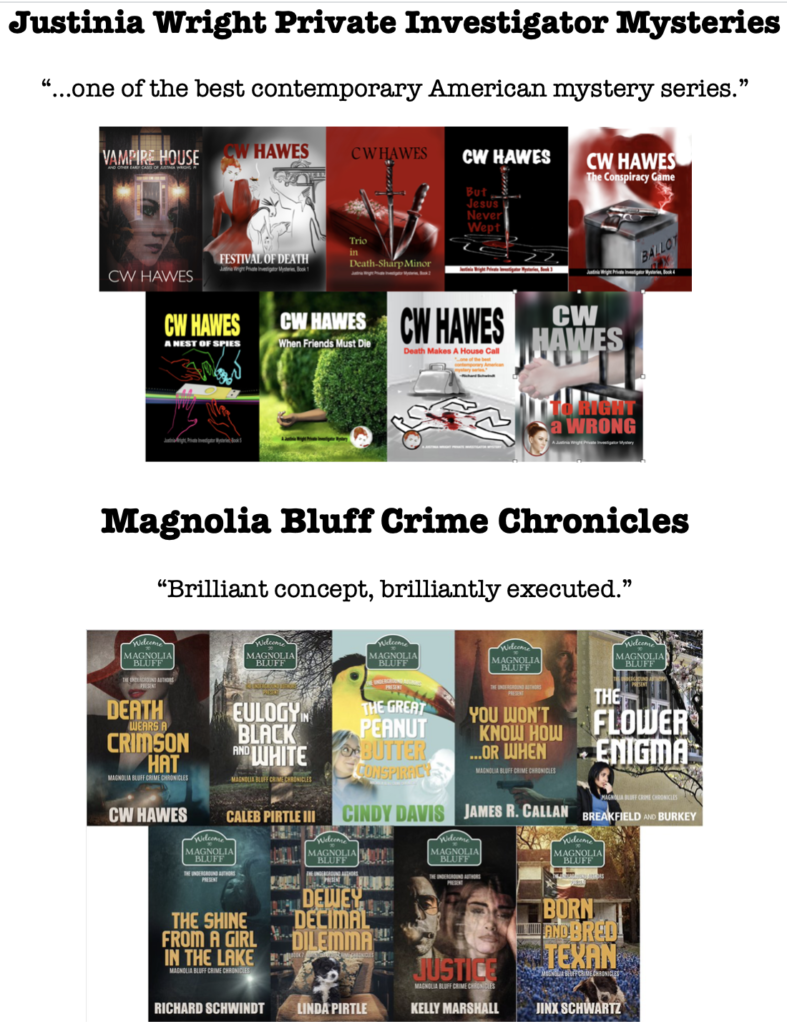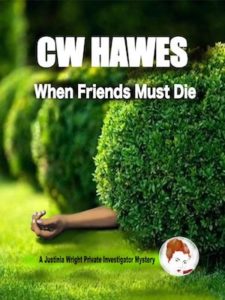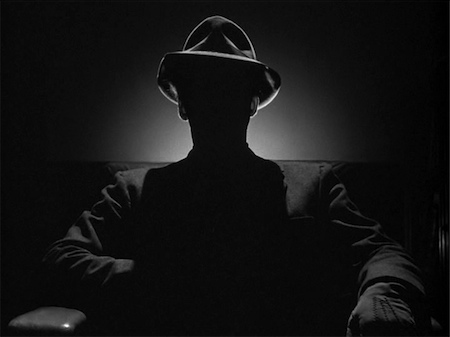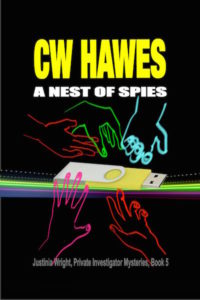
The sale is now over — hope you got your copy!
Murder and mayhem. Plus Tina’s being framed for murder!
A Nest of Spies is the 5th book in the Justinia Wright Private Investigator Mysteries series.
Starting 5 am PDT on Wednesday, August 18th, the book will be on a 137 hour sale. For only 99¢! That’s a 76% deep discount.
Get A Nest of Spies on Amazon!
Joe Congel, author of the wonderful Tony Razzolito mysteries, had this to say about A Nest of Spies:
If you’re not reading this wonderful Private Investigator Mystery series, you should be.
CW Hawes has created a cast of characters that I believe stand tall next to any traditional detective, whodunnit mystery you want to put them up against. In this, the 5th installment of the series, the reader gets a peek into private eye, Justinia Wright’s secretive government past. A past that she never talks about, not even with her brother, Harry.
But when government (the U.S as well as other countries) spies and contract killers start appearing on her doorstep, it becomes obvious to Harry that his baby sister may still have at least one toe dipped in a pool filled with espionage and treason.
Spies can be a funny bunch; they will put their mutual trust in one another when it’s beneficial to them, but will not hesitate to pull the trigger to save themselves. And all the while, you cannot believe a word any of them say.
When a former agency partner tries to unsuccessfully hire Tina to help secure a flash drive with plans for a top-secret weapon by posing as the buyer, it is just the beginning of a fun, interesting mystery filled with lots of twists and turns.
As more and more people from Tina’s past show up wanting to talk with and hire the great detective’s services, the lies… and the body count begin to grow. And when Tina is accused of murder, she and her team of sleuths devise a scheme to recover the missing flash drive, catch a murderer, clear their names, and in the process make a little profit for their troubles.
With all that is going on in this story, you would think that the Wrights would have time for nothing else. And as interesting as the main plot of this novel is, the subplot that fleshes out the on again, off again relationship saga between Tina and police Lieutenant Cal Swenson, all the fabulous meals cooked up by Harry and his wife Bea, and the side characters like Tina’s tenant, the quirky artist wannabe, Solstice, is perhaps what really makes this series special.
Hawes has developed characters that you can’t help but care about. It’s what makes me continue to buy and read every book in this series. I really want to know what’s going on in Tina and Harry’s personal life as well as how they will solve the mystery at hand.
I highly recommend A Nest of Spies. It is my favorite Justinia Wright Mystery so far, and I can’t wait to dive into the next one to see where the mystery and mayhem takes this talented brother and sister detective duo.
KD McNiven, author of the very fine Detective Brock Scanlin mystery series, had this to say:
…I have read several of CW Hawes’s books and have thoroughly enjoyed each one. I especially like his Justina Wright books because they are the traditional whodunit mysteries that keep you flipping the pages. And CW just writes darned outstanding books. Justinia (Tina) is a colorful six-foot-tall redhead character who is a private investigator, a connoisseur of painting, and an accomplished pianist. Her brother Harry works alongside her, and they make a great team.
There are plenty of twists and turns in A Nest of Spies to keep you reading through the night. You can’t help but join in on the fun and mayhem. I highly recommend A Nest of Spies! A fantastic mystery series.
High praise, which I feel very honored to receive as it comes from such fine writers.
Below is a snippet, from Chapters 7 and 8, for your reading pleasure.
All was quiet for a few moments and then Cal spoke. “Gaddison was shot with a thirty-two. There aren’t many of those around. Mind if I take a look at yours, Tina?”
The look on Tina’s face would’ve iced over the Amazon.
“Yes, I mind. I didn’t shoot Gaddison, Swenson. And if I had, all I needed to do was make one phone call and the crime scene would have been cleaned to the point where even God would’ve thought He’d just made the place.”
“Look, Wright, I’m just doing my job. Don’t make this any tougher for me than it already is.”
She paused long enough for the temperature in her demeanor to thaw out and actually exude some warmth.
“Okay, Swenson, I’ll humor you. Harry, get my revolvers.”
We keep most of our guns locked up, although we each have one or two in a drawer in our respective desks and I know I have one in my room upstairs. I unlocked the safe and got out her two revolvers. A nod of her head in Cal’s direction indicated I should take them to him. He looked them over, smelled them, popped out the cylinders, put them back, and handed the guns back to me.
“Satisfied?” Tina asked.
“On the revolvers? Yes, they don’t appear to have been fired recently.”
“They haven’t, Swenson.”
“Still might want to run a ballistics check on them. What ammo do you use?”
“Federal eighty-five grain jacketed hollow points.”
“Do you own a thirty-two caliber semi-auto?”
“What the hell, Swenson? No, I don’t.”
“You mind telling me what you did last night?”
“Am I a suspect?”
“Well, we found what we think is the murder weapon. A little Yugoslav CZ Model 70 in thirty-two.”
“I don’t own one and, as I already told you, I don’t own any semi-autos in thirty-two.”
“Care to tell me why your fingerprints are on the gun?”
I know Tina pretty well. She’s as cool as that proverbial cucumber under pressure. But when Cal asked her that question, I could swear she blanched.
“I have no idea, Swenson.”
“I had them hold off doing a ballistics test until I talked to you. So you don’t own any thirty-two caliber semi-autos. Just the two revolvers.”
“Correct.”
“I won’t get any surprises doing a registration check.”
“No.”
“So where were you last night?”
Tina took in a deep breath and exhaled. “I went out with a friend. We had supper and took in a movie. Then I went to his place for a bit, we got into an argument, and I left. I was pissed and drove around for awhile before coming home.”
“When did you leave his place?”
“Around eleven.”
“When did you get home?”
“About one.”
“You were out driving around for two hours?”
“Yes, Swenson. I was driving around by myself for two hours and therefore no one can corroborate where I was. Hell, I’m not sure I know where I went. I was pissed and just drove around. When was Gaddison shot?”
“Around midnight. Give or take a half-hour. Which means you don’t have an alibi.”
“My prints just on the gun or are they on the ammo too?”
“As far as I know, just the gun.”
“Cal, I didn’t shoot him. I would have loved to have been the one to pull the trigger, but I didn’t. As for my prints, I have no explanation.”
“We’ll run a ballistics test. If it is the murder weapon… Well, you know what that means. I’ll let you know as soon as I hear something.”
“Thanks, Cal.”
“Any idea who might want to frame you?”
“No one in Minneapolis.”
He nodded and stood. “That should do it for now.”
Cal left and Bea followed him out, returning in a couple of minutes. She sat on the chesterfield and asked, “Is this spy stuff, Tina?”
“Don’t know for sure. Probably.”
“What I want to know,” I began, “is how did your prints get on a gun you don’t even own?”
Tina shook her head. “I have no idea.” She turned to Bea. “What did the guy look like who delivered the special delivery letter?”
“It wasn’t a guy. It was a woman. Kind of masculine looking, but she looked like a woman to me.”
Tina shrugged. “I have no idea.”
“If this is spy stuff, governments sure do a lot of bad things, don’t they.”
Tina had a far away look on her face. “Yes, they do, Bea. Yes, they do.”
I hope you enjoyed that little morsel.
Get A Nest of Spies for only 99¢ starting tomorrow, August 18th. Sale ends 10 pm PDT on August 23rd. So don’t wait!
Share This!

 CW Hawes is a playwright; award-winning poet; and a fictioneer, with a bestselling novel. He’s also an armchair philosopher, political theorist, social commentator, and traveler. He loves a good cup of tea and agrees that everything’s better with pizza.
CW Hawes is a playwright; award-winning poet; and a fictioneer, with a bestselling novel. He’s also an armchair philosopher, political theorist, social commentator, and traveler. He loves a good cup of tea and agrees that everything’s better with pizza.